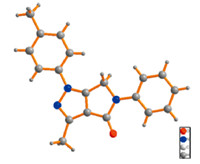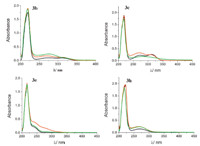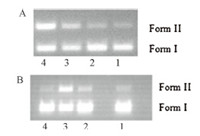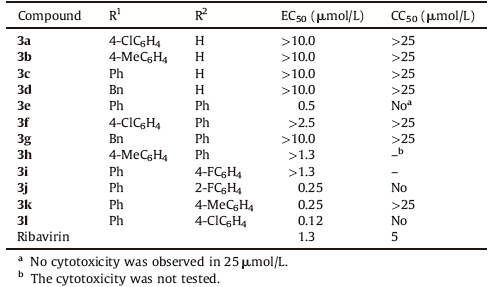b School of Life Sciences, Zhengzhou University, Zhengzhou 450001, China
It is well-known that DNA possesses sufficient stability under physiological conditions to prevent premature degradation or accidental altering [1]. Such stability is essential to any living being,as DNA contains the genetic code of an organism. Therefore, construction of the agents that are capable of efficiently cleaving DNA represents a challenging topic. DNA-cleaving molecules have indispensable catalytically active centers that are generally incorporated with DNA-recognizing units [2, 3, 4, 5, 6]. To create effective cleaving agents,one of the key point lies in the selection of DNAbinding units,as DNA-binding is widely recognized as a critical step for DNA cleavage in most cases [2]. Metal ions have been implicated as cofactors in the strand scission of DNA for a number of antitumor antibiotics [7]. DNA cleaving reagents have attracted continuous and extensive interest due to their potential applications in the fields of molecular biological technology and drug development [8]. Among them,DNA cleavage promoted by transition metal complexes has been widely investigated in the last decade [9].
Viruses belonging to the Flaviviridae family cause clinically significant diseases in humans and animals [10]. Hepatitis C virus (HCV: a member of the Flaviviridae family) is thought to be a major cause of human hepatitis [11]. Currently,no vaccine is available to prevent HCV infection [12]. Like HCV,bovine viral diarrhea virus (BVDV) also belongs to the Flaviviridae family [13]. BVDV is considered to be a valuable surrogate virus model for identifying and characterizing antiviral agents for using against HCV [14].
Pyrazole ring is a ubiquitous motif in biologically active compounds and therefore represents an interesting template for combinatorial as well as medicinal chemistry [15]. Pyrazole derivatives are the subject of many researches due to their widespread potential biological activities [16]. In addition, pyrazole fused heterocycle systems like pyrrolo-pyrazole [17], pyrazolo-pyridines,pyrano-pyrazoles and pyrazolo-pyridopyrimidines present interesting biological properties such as anticancer [18],fungicidal and bactericidal [19]. A considerable attention has been focused on the development of new methodologies to synthesize many kinds of these pyrazole fused heterocycles as well as pyrazole-based metal complexes [20]. In addition,tetramic acid (2,4-pyrrolidinedione) are important in medicinal chemistry,as they display antineoplastic,antiviral,HIV-1 protease-inhibiting, insecticidal,and antibacterial properties [21]. In this paper,we report the design and synthesis of a series of fused heterocyclic pyrazole derivatives containing tetramic acid subunit,as well as the studies of their DNA cleavage activities and the evaluation of their anti-BVDV activities. We anticipate that our pyrazole fused heterocyclic ligands would be adequate to stabilize metal complexes with potential activity as chemical nucleases. 2. Experimental 2.1. Chemistry
All reagents and solvents were obtained from commercial suppliers without further purification except otherwise indicated. Commercial grade solvent was dried and purified by standard procedures. All the reactions were monitored by TLC. Melting points were determined on a Beijing Keyi XT5 apparatus and the temperature was not corrected. 1H NMR and 13C NMR spectra were collected on a Bruker DPX 400 NMR spectrometer with TMS as an internal reference. IR spectra were recorded as KBr pellets on a Thermo Nicolet (IR 200) Spectrometer. High-resolution mass spectra (HRMS) were obtained on a Waters Micromass Q-Tof MicroTM instrument using the ESI technique. Ultraviolet-visible (UV-vis) absorption spectra were recorded on a Lambda35 spectrophotometer. PXRD Patterns were recorded using Cu Ka1 radiation on a PANalytical X’Pert PRO diffractometer.
The synthetic route of the target pyrazole containing compounds 3 is outlined in Scheme 1 which contains two steps as follows. In the first step,the Dieckmann condensation of 1, prepared according to previously published methods [22],was carried out using toluene as solvent to yield the intermediate 3- acetyltetramic acids 2,which further reacted with different hydrazine in the second step in the presence of catalytic amount of acetic acid in ethanol to yield the desired products 3 [23]. All the target molecules 3 were characterized by IR,1HNMR,13C NMR,and mass spectrometry techniques. The molecular structure of compound 3k was confirmed by X-ray diffraction analysis (Fig. 1).

|
Download:
|
| Scheme 1. The synthetic route of compound 3. (a) NaOMe,toluene,60 ℃ and (b) NH2NHR2,EtOH,reflux. | |

|
Download:
|
| Fig 1. X-ray structure of compound 3k. | |
General procedure: A solution of compound 1 (5 mmol) in toluene (12 mL) was added to sodium methoxide [from sodium (0.12 g) and methanol (3 mL)]. The mixture was stirred at 60 ℃ for 7 h and concentrated under reduced pressure. Then,water (5 mL) and conc. HCl (0.5 mL) was added and stirred for another 0.5 h. The precipitated product was filtered and washed with water to afford the pure 2. Next,a solution of compound 2 (4 mmol) in ethanol (5 mL) was added to different hydrazine (4.5 mmol) and refluxed. After completion of the reaction confirmed by TLC,the reaction mixture was cooled to room temperature and concentrated under reduced pressure. Then,the residue was chromatographed with petroleum ether-ethyl acetate (2:1,v/v) to give compound 3. Selected spectral data are listed below and the others were given in Supporting information.
3k: Yellow solid; Yield 69%; mp 185-186 ℃; IR (KBr,cm-1): ν 3366,3043,1691,1602,1555,1486; 1H NMR (400 MHz,CDCl3): δ 7.71 (m,2H,ArH),7.47 (m,2H,ArH),7.40 (m,2H,ArH),7.28 (m,2H, ArH),7.14 (m,1H,ArH),4.90 (s,2H,CH2),2.53 (s,3H,CH3),2.40 (s, 3H,CH3); 13C NMR (100 MHz,CDCl3): δ 162.61,148.79,145.50, 139.94,136.87,136.52,130.31,129.17,124.10,121.32,119.33, 118.58,46.61,21.01,12.46; HRMS (ESI): m/z [M+H]+ calcd. for C19H18N3O: 304.1444,found: 304.1446. 2.2. Plasmid DNA cleavage
Plasmid DNA (pUC 19) cleavage activity of compounds 3 was monitored by using agarose gel electrophoresis. In a typical experiment,supercoiled pUC19 DNA (0.5 μL) in Tris-HCl buffer (11.5 μL) was treated with compounds 3 in the Eppendorf tube (1 mL). The samples were then incubated at 37 ℃ for 24 h. Agarose gel electrophoresis was carried out at 40 V for 30 min in TAE (Trisacetate- EDTA) buffer containing 2 mL EB. The resolved bands were visualized were visualized by UV light and photographed followed by the estimation of the intensity of the DNA bands using a Gel Documentation System. 2.3. Cytotoxicity assay
MDBK cells were seeded at a density of 7×103 per well in 96- well plate in RPMI 1640-FBS medium. Then the supernatant was removed after incubation at 37 ℃,5% CO2 for 24 h and replaced with 200 μL of maintenance medium,without or with test compounds (20 μmol/L). After 48 h incubation at 37 ℃,20 μL MTT (0.5 mg/mL) was added and the reaction was terminated by removal of the supernatant. Then 200 μL of DMSO was added to each well to dissolve the formazan product. Optical density (OD) of each well was measured at 570 nm with PowerWaveX Microplate Scanning Spectrophotometer (Bio-tek Instruments,Inc.). Then the inhibitory percentage of each compound to the cell proliferation was calculated. 3. Results and discussion
3.1. Electronic absorption study
DNA binding is the critical step for DNA cleavage in most cases. Therefore,the potential binding abilities of the metal complexes of some pyrazole derivatives to DNA were studied in a Tris-HCl buffer (50 mmol/L,pH 7.0) by using UV-vis absorption spectroscopy. The typical absorption curves for compounds 3b,3c,3e,3h,their Cu2+ complexes as well as the 3-Cu(II)-DNA mixture are shown in Fig. 2. From the results we can find that compounds 3b and 3c displayed distinct binding behaviors for Cu(II) and DNA respectively, whereas compounds 3e and 3h,which have substituent on the pyrazole ring,showed no binding abilities. The absorption bands of 3b (3c) at 270 and 320 nm obviously red-shift after the addition of Cu2+ and DNA,indicating that the ligands experienced interactions with Cu2+ ion and DNA at room temperature after 24 h. This result is consistent with that we following obtained in the DNA binding and cleavage studies. Compairing the structures of 3b,3c with 3e, 3h,we can conclude that the aromatic substituent on pyrazole N atom is not facilitate their Cu2+ and DNA binding behaviors.

|
Download:
|
| Fig 2. UV-vis absorption spectra relative to compounds 3b,3c,3e and 3h. Black: compound 3; Red: compound 3-Cu(II) after 24 h at room temperature; Green: compound 3- Cu(II)-DNA after 24 h at room temperature. | |
The effect of the various ligands (3a-3l) and their respective metal complexes (3-M) on supercoiled DNA was studied using different concentrations of the compounds at 37 ℃ during an incubation period in a special buffer,in the absence or presence of external agents under physiological conditions. After this time of incubation,all the metal complexes might be able to induce conformational changes in DNA,following the same pattern but differing in the extent of the effect. The interaction of these complexes with DNA would give rise to DNA isoforms. When circular plasmid DNA is conducted by electrophoresis,the different migrations will be observed for the supercoiled form (Form I) and the nicked circular form (Form II).
Firstly,the ligand-dependent DNA cleavage by complexes 3b-Cu2+,3e-Cu2+ and 3l-Cu2+ was performed. Fig. 3A shows the results of gel electrophoretic separations of plasmid DNA induced by the three complexes in the absence of external agent under pH 7.0 and at 37 ℃ for 5 h. Only in the case of 3b-Cu2+,Form I plasmid DNA was gradually converted into Form II,indicating that complex 3b-Cu2+ shows higher nuclease activity than other two complexes. Accordingly,compound 3b was chosen as the key ligand in the subsequent experiments. Then,we studied the DNA cleavage activity of complexes of 3b with other transition metal ions. A solution containing plasmid DNA was incubated in a 0.5 mL tube with catalyst 3b-Zn2+,3b-Cu2+ and 3b-Co2+ (0.2 mmol/L,respectively) in a Tris-HCl buffer (50 mmol/L,Ph 7.0) at 37 ℃ for 5 h. The results are shown in Fig. 3-B. From Fig. 2-B it can be seen that complex 3b-Cu2+ is more reactive than 3b-Zn2+ and 3b-Co2+. It may suggest that the kind of metal ion and the structural effect of the ligands play an important role in the DNA cleavage. Thus,3b-Cu2+ was chosen as the more effective complex to optimize the cleavage conditions.

|
Download:
|
| Fig 3. A. Effect of Cu complex of different ligands 3b,3e,3l (0.2 mmol/L) on the cleavage reactions of pUC19 DNA (0.5 μg/μL),Tris-HCl buffer (50 μmol/L,pH 7.0), at 37 ℃ for 5 h,lane 1: DNA control; lane 2: 3l-Cu2+; lane 3: 3e-Cu2+; lane 4: 3b- Cu2+; B. Effect of different metal complex (0.2 mmol/L) on the cleavage activity of pUC19 DNA by complex 3-M: pUC19 DNA (0.5 μg/μL),at 37 ℃ for 5 h,Tris-HCl buffer (50 mmol/L,pH 7.0),lane 1: DNA control; lane 2: 3b-Zn2+; lane 3: 3b-Cu2+; lane 4: 3b-Co2+. | |
The effect of pH value on the catalytic activity of 3b-Cu2+ was then studied. Incubation of the supercoiled pUC19 DNA with complex 3b-Cu2+ (0.2 mmol/L) for 24 h at 37 ℃ resulted in a different extent of cleavage of DNA depending on the different pH value of the buffer. In Fig. 4,line 1 and line 9 stand for the neat DNA control (without both ligand and metal ion) under pH 6.5 and 8.5, respectively. Lines 2-8 shows that,regardless of acidic,basic or neutral conditions (pH 6.5-8.5),the DNA cleavage could take place with similar results. The lower transforming ratio at pH 8.5 implied that stronger basicity may be unfavorable for the DNA cleavage. The result indicated that complex 3b-Cu2+ owns good applicability in different pH condition (Fig. 4,lanes 2-8). Therefore,the physiological condition (pH 7.0) was selected for all of the following DNA cleavage reactions.

|
Download:
|
| Fig 4. Effect of different pH value on the cleavage activity of pUC19 DNA (0.5 μg/μL) with complex 3b-Cu2+ (0.2 mmol/L) in Tris-HCl buffer at 37 ℃ for 24 h; lane 1: DNA control (pH 6.5); lane 9: DNA control (pH 8.5); lanes 2-8,pH 6.5,6.8,7.0,7.2, 7.5,8.0,8.5. | |
The cleavage of DNA by different concentrations of complex 3b- Cu2+ was also investigated (Fig. 5). Cleavage reactions that create relaxed circular DNA from supercoiled DNA under various concentrations of 3b-Cu2+ and constant DNA concentration were carried out for 24 h at 37 ℃ in the buffer of pH 7.0. At 0.05 mmol/L, complex 3b-Cu2+ cleaves about 80% of the plasmid to yield the nicked circular form. Increasing the concentration of 3b-Cu2+ resulted in the increasing yield of nicked form (lanes 2-6). When the concentration of 3b-Cu2+ was increased to 0.20 mmol/L,the plasmid DNA could be completely cleaved to the nicked form in 24 h (lanes 5 and 6). Therefore,it indicated that the proper concentration of complex 3b-Cu2+ is 0.20 mmol/L.

|
Download:
|
| Fig 5. Effect of concentration on the cleavage activity of pUC19 DNA (0.5 μg/μL) with complex 3b-Cu2+ in Tris-HCl buffer at 37 ℃ for 24 h,pH 7.0; lane 1: DNA control; lanes 2-6: 0.05 mmol/L,0.1 mmol/L,0.15 mmol/L,0.20 mmol/L, 0.25 mmol/L. | |
The effect of reaction time on the DNA cleavage is shown in Fig. 6. From the results we can see that conversion rate of the two forms could be improved by extending the incubation time. After incubating for 12 h,the percentage of the nicked form rose to 92% (lane 6). All the plasmid DNA could be almost fully converted into nicked form in about 24 h (lane 8). So the suitable reaction time is 24 h.

|
Download:
|
| Fig 6. Effect of reaction time on the cleavage activity of pUC19 DNA (0.5 μg/μL) with complex 3b-Cu2+ (0.2 mmol/L) in Tris-HCl buffer at 37 ℃ for 24 h,pH 7.0; lanes 1-11: 0.5 h,1 h,3 h,5 h,7 h,12 h,18 h,24 h,32 h,48 h,72 h. | |
Under the optimized DNA cleavage conditions,the cleavage activities of the Cu(II) complexes of all the 12 pyrazole derivatives, 3a-3l,for pUC 19 supercoiled DNA were studied (Fig. 7). Analytical results showed that whether N-substituted or unsubstituted of the target compounds have remarkable influence on the DNA cleaving abilities of the Cu(II) complex of the pyrazole derivatives. We can find that compounds 3a-3c,having no pyrazole N-substituent, showed excellent DNA cleaving abilities compared to the compounds with pyrazole N-substituent. Considering only the pyrazole N-unsubstituted compounds,it is worth-noting that while changing R1 from different substituted phenyl group to benzyl group,the DNA cleaving activity of the pyrazole derivatives decreased remarkably.

|
Download:
|
| Fig 7. Different target compounds cleavage the pUC19 DNA at the best cleavage condition. Lane 1: DNA control. | |
It is known that nucleic acids can be cleaved through an oxidative or hydrolytic pathway. Therefore,to gain insight into the probable mechanism of action,typical scavengers for reactive oxygen species (ROS),including NaN3 (singlet oxygen scavenger,10 mmol/L),KI (superoxide scavenger,10 mmol/L), t-BuOH and DMSO (hydroxyl radical scavenger,1 mmol/L),were introduced,respectively,to the 3b catalyzed cleavage system. Fig. 8 shows that none of these scavengers displays evident inhibition effect,which suggests that ROS is not involved in the cleavage process. Therefore,the DNA cleavage promoted by 3b should not occur via an oxidative pathway but via hydrolytic pathway.

|
Download:
|
| Fig 8. The reaction mechanism on the cleavage activity of pUC19 DNA (0.5 μg/μL) with comple 3b-Cu2+ (0.2 mmol/L) in Tris-HCl buffer at 37 ℃ for 24 h,pH 7.0; lane 1: DNA control; lane 2: DNA+3b-Cu2+; lane 3: DNA+3b-Cu2++NaN3; lane 4: DNA+3b-Cu2++KI; lane 5: DNA+3b-Cu2++DMSO; lane 6: DNA+3b-Cu2++tert-butyl alcohol. | |
Compounds 3a-3l were initially evaluated for their antiviral activity against BVDV (a pestivirus,bovine viral diarrhea virus) in MDBK (Madin-Darby bovine kidney) cells and for their cytotoxicity by MTT method,with Ribavirin as positive control. The results were summarized in Table 1. Some compounds displayed high antiviral activity with interesting EC50 values,especially compounds 3j-3l showed pronounced antiviral activities with an EC50 value of 0.12-0.25 μmol/L and no significant cytotoxicity,which were better than that of the Ribavirin (EC50 = 1.3 μmol/L).
| Table 1 Anti-BVDV activity of pyrazole derivatives 3a-3l. |
Preliminary SAR showed that different substitution at the pyrazole N atom exhibited significant effect on their antiviral activities. The pyrazole N unsubstituted compounds (Table 1, compounds 3a-3d),showed no remarkable antiviral activities, indicating an importance of the pyrazole N-substitution. When replacing the N-hydrogen atom by phenyl group,their antiviral activities were obviously improved (Table 1,compounds 3e-3h).Especially,while different substituted phenyls were introduced to the pyrazole N,where the substituent on the lactam N (R1) is unsubstituted phenyl,their antiviral activities were further improved (Table 1,compounds 3i-3l). Compound 3l (R1 = Ph, R2 = 4-ClC6H4) was the most potent in a series of substituted phenyl derivatives with an EC50 value of 0.12 μmol/L,which was 10 fold more active than that of the positive control ribavirin (EC50 = 1.3 μmol/L),and 3j (R1 = Ph,R2 = 2-FC6H4) and 3k (R1 = Ph, R2 = 4-MeC6H4) also showed high antiviral activities with EC50 values of 0.25 μmol/L,respectively. 4. Conclusion
In conclusion,we have successfully synthesized a series of novel pyrazole fused heterocyclic derivatives via a two-step procedure or a one-pot two step strategy,and investigated their catalytic DNA cleavage abilities and anti-BVDV activities. With 3b- 3c,the plasmid DNA could be cleaved from Form I to Form II completely via a hydrolytic mechanism under mild conditions in a short time. Meanwhile,most of the tested compounds exhibited excellent anti rival activities against BVDV with no significant cytotoxicity. Among them,compound 3l showed the highest antiviral activity (EC50 = 0.12 μmol/L) and was 10 fold lower than that of the positive control ribavirin (EC50 = 1.3 μmol/L). Further research on new pyrazole derivatives for treatment of HCV infection is ongoing in our laboratory,and the results will be reported in due course.
AcknowledgmentWe thank the National Natural Science Foundation of China (Nos. 21105091 and 20772113) for the financial support.
| [1] | F. Mancin, P. Scrimin, P. Tecilla, U. Tonellato, Artificial metallonucleases, Chem. Commun. 20 (2005) 2540-2548. |
| [2] | C.J. Thomas, M.M. McCormick, C. Vialas, et al., Alteration of the selectivity of DNA cleavage by a deglycobleomycin analogue containing a trithiazole moiety, J. Am. Chem. Soc. 124 (2002) 3875-3884. |
| [3] | A. Minnock, L.S. Lin, J. Morgan, et al., Sequence-specific DNA cleavage by dipeptides disubstituted with chlorambucil and 2,6-dimethoxyhydroquinone-3-mercaptoacetic acid, Bioconjug. Chem. 12 (2001) 870-882. |
| [4] | C.Q. Zhou, Y.L. Lin, J.X. Chen, et al., Facile synthesis of a dimeric dipyrrolepolyamide and synergetic DNA-cleaving activity of its Cu(II) complex, Bioorg. Med. Chem. Lett. 22 (2012) 5853-5856. |
| [5] | M. Pitié, J.D.V. Horn, D. Brion, C.J. Burrows, B. Meunier, Targeting the DNA cleavage activity of copper phenanthroline and clip-phen to A.T. tracts via linkage to a poly- N-methylpyrrole, Bioconjug. Chem. 11 (2000) 892-900. |
| [6] | M. Pitié, C.J. Burrows, B. Meunier, Mechanisms of DNA cleavage by copper complexes of 3-clip-phen and of its conjugate with a distamycin analogue, Nucleic Acids Res. 28 (2000) 4856-4864. |
| [7] | (a) S. Roy, P.U. Maheswari, M. Lutz, et al., DNA cleavage and antitumour activity of platinum(II) and copper(II) compounds derived from 4-methyl-2-N-(2-pyridylmethyl) aminophenol: spectroscopic, electrochemical and biological investigation, Dalton Trans. 48 (2009) 10846-10860; |
| [8] | (a) Y. Aiba, J. Sumaoka, M. Komiyama, Artificial DNA cutters for DNA manipulation and genome engineering, Chem. Soc. Rev. 40 (2011) 5657-5668; |
| [9] | (a) L. Tjioe, J. Brugger, B. Graham, L. Spiccia, Synthesis, structure, and DNA cleavage properties of copper(II) complexes of 1,4,7-triazacyclononane ligands featuring pairs of guanidine pendants, Inorg. Chem. 50 (2011) 621-635; |
| [10] | K. Sako, H. Aoyama, S. Sato, Y. Hashimoto, M. Baba, Gamma-carboline derivatives with anti-bovine viral diarrhea virus (BVDV) activity, Bioorg. Med. Chem. 16 (2008) 3780-3790. |
| [11] | (a) T.J. Liang, B. Rehermann, L.B. Seeff, J.H. Hoofnagle, Pathogenesis, natural history, treatment, and prevention of hepatitis C, Ann. Intern. Med. 132 (2000) 296-305; |
| [12] | (a) D.Z. Chen, J.D. Jiang, K.Q. Zhang, et al., Evaluation of anti-HCV activity and SAR study of (+)-lycoricidine through targeting of host heat-stress cognate 70 (Hsc70), Bioorg. Med. Chem. Lett. 23 (2013) 2679-2682; |
| [13] | (a) H.W. Xu, L.J. Zhao, H.F. Liu, et al., Synthesis and anti-BVDV activity of novel dsultones in vitro: implications for HCV therapies, Bioorg. Med. Chem. Lett. 24 (2014) 2388-2391; |
| [14] | (a) V.E. Buckwold, J. Wei, M. Wenzel-Mathers, J. Russell, Synergistic in vitro interactions between alpha interferon and ribavirin against bovine viral diarrhea virus and yellow fever virus as surrogate models of hepatitis C virus replication, Antimicrob. Agents Chemother. 47 (2003) 2293-2298; |
| [15] | (a) S. Ningaiah, U.K. Bhadraiah, S.D. Doddaramappa, S. Keshavamurthy, C. Javarasetty, Novel pyrazole integrated 1,3,4-oxadiazoles: synthesis, characterization and antimicrobial evaluation, Bioorg. Med. Chem. Lett. 24 (2014) 245-248; |
| [16] | (a) B.P. Bandgar, H.V. Chavan, L.K. Adsul, et al., Design, synthesis, characterization and biological evaluation of novel pyrazole integrated benzophenones, Bioorg, Med. Chem. Lett. 23 (2013) 912-916; |
| [17] | I.K. Sorokina, V.A. Parshin, V.V. Asnina, R.B. Parimbetova, V.G. Granik, Novel 2- pyrrolidone derivatives closely related to piracetam: synthesis and pharmacological study, Khim. Farm. Zh. 26 (1992) 41-44. |
| [18] | E.M. Gsiusky, S. Lee, C.W. Sigle, D.S. Duch, C.A. Nichol, Synthesis and antitumor activity of 2,4-diamino-6-(2,5-dimethoxybenzyl)-5-methylpyrido[2,3-d]pyrimidine, J. Med. Chem. 23 (1980) 327-329. |
| [19] | M.N. Nasr, M.M. Gineinah, Pyrido[2,3-d]pyrimidines and pyrimido[50,40:5,6]pyrido[2,3-d]pyramidines as new antiviral agents: synthesis and biological activity, Arch. Pharm. Med. Chem. 335 (2002) 289-295. |
| [20] | J. Quiroga, J. Portilla, H. Serrane, et al., Regioselective synthesis of fused benzopyrazolo[3,4-b]quinolines under solvent-free conditions, Tetrahedron Lett. 48 (2007) 1987-1990. |
| [21] | (a) C. Han, T. Zhang, A.Q. Zhang, et al., Efficient catalyst-free one-pot threecomponent synthesis of novel spirooxindole derivatives and their cytotoxic activities, Synthesis 46 (2014) 1389-1398; |
| [22] | R.N. Lacey, Derivatives of acetoacetic acid. Part VII. α-acetyltetramic acids, J. Chem. Soc. (1954) 850-854. |
| [23] | S. Gelinx, B. Chantegrel, M. Chabannet, Synthesis of 4-oxo-1,4-dihydro-6Hfuro[3,4-c]pyrazole and 4-oxo-1,4,5,6-tetrahydropyrrolo[3,4-c]pyrazole systems from acyl tetronic and tetramic acids, Synth. Commun. 12 (1982) 431-437. |





